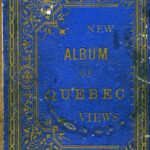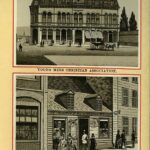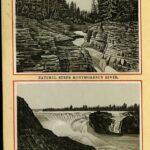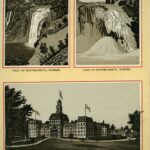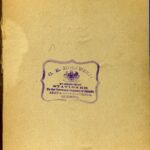
It’s that time of year again : when exhausted archivists, archival technicians and assistants emerge from a chaotic maelstrom of processing work — finely polished finding aid clutched firmly in hand and a trail of beautifully organized boxes left in their wake.
It is my pleasure to introduce you to this year’s newest additions. May the collections intrigue and excite you as much as they have done us.
MG 543 – Carlyle Allison fonds
Carlyle Allison was a journalist, and close friend and advisor of Prime Minister John Diefenbaker. Born in Staynor, Ontario in 1907, his family moved to Winnipeg when he was a child. He attended the University of Manitoba (B.A., 1926). His journalism career started immediately after graduation: starting as a reporter and editor with the Winnipeg Tribune, 1926-1928; and reporter, bureau chief and editor with the Saskatoon Star-Phoenix, 1928-1935. After a brief stint with the Montreal Gazette, he returned to the Winnipeg Tribune, progressing through the ranks as managing editor (1944), editor (1946), and editor-in-chief (1951). In 1958, he was appointed by Prime Minister Diefenbaker as a full-time (and founding) member of the Board of Broadcast Governors, the precursor to the CRTC. He served as Vice-Chairman between December 1960 and 1965, but his term was not renewed by the new Liberal government. Subsequently he worked for CJAY-TV in Winnipeg, until his retirement in 1971. He died in February 1972.
The collection consists primarily of correspondence, photographs and memorabilia documenting Allison’s friendship and political association with John Diefenbaker – starting with Allison’s advice to Diefenbaker about his leadership convention in 1948. In addition to correspondence, there are a few detailed notes documenting conversations between Allison and Diefenbaker, including a 19-page document entitled “Notes on the Election of the Diefenbaker Government” (1957), which also covers the appointment of Diefenbaker’s first cabinet.
MG 163 – David C. Carpenter fonds
The most recent set of materials from one of Saskatchewan’s most well-known authors includes correspondence with a number of other notable names in Saskatchewan’s writing scene. Samples of Carpenter’s own writing and opinion pieces are present. Notably, materials collected in the writing of Carpenter’s acclaimed book The Education of Augie Merasty including correspondence with the 86 year old residential school survivor are contained within this accrual. Carpenter has also donated extensive research materials on the literary history of the province, including interviews with several authors. Personal ephemera, as well as material from various writing events are also included.
MG 390 – Dave Glaze fonds
Born in New Westminster, British Columbia, Dave Glaze grew up in Alberta, Ontario and Saskatchewan. He earned a BA (1968) and B.Ed (1983) from the University of Saskatchewan. He worked for twenty-five years as an elementary teacher, librarian and education consultant. Specializing in juvenile fiction, his books Pelly, Who took Henry and Mr. Z?, Waiting for Pelly, The Light-Fingered Gang, The Last Flight of the Birdman and Danger in Dead Man’s Mine were all published by Coteau Books. Glaze also served on the editorial boards of Green Teacher, Briarpatch and NeWest Review magazines. Thousands of Canadian children have attended his book readings. The material in this fonds deal with Glaze’s life including school and extracurricular interests as a youth and later as a journalist, fiction writer, editor and educator.
MG 354 – B. A. Holmlund fonds
Blaine Adrian Holmlund began working at the age of 12 as a hired farm laborer in 1942. From these humble beginnings, he went on to work with the CPR, and eventually get his degree in Engineering in 1955. After convocation, Blaine worked variously with Shell Oil, Atomic Energy of Canada, and Sask Power. In 1958 he joined the faculty of the University of Saskatchewan, where he remained for the rest of his career, coming to fill the position of Acting President of the University in 1989. He was awarded an honorary doctorate in 1998, and spent his retirement volunteering with Habitat for Humanity, helping to initiate partnerships with employment programs and to establish the Re-Store. This fonds reflects Holmlund’s interest in the philosophy of education, his varied career at the University of Saskatchewan, and his concern for an equitable society. It is particularly valuable as a source for university history, specifically for the period of Leo Kristjanson’s tenure; and for issues surrounding health delivery, education, and the College of Medicine; the development of computer / IT services on campus; and First Nations educational opportunities. As a reflection of planning at a post-secondary U-15 institution, this fonds is particularly strong, notably for the materials surrounding the Issues and Options project.
MG 183 – Mac & Beth Hone fonds
This accrual expands on the already fascinating array of personal and art or art-related materials donated to the archives in the past. The materials added this year provide additional materials relating to the Hone’s family, friends, and also expands the collection of their artwork held by the Archives, including materials used in process (sketches, printing blocks, etc) as well as completed pieces.
MG 282 – David Kaplan fonds
David Leon Kaplan was born in Chicago on Dec. 12, 1923 and grew up in a musical family. His father, Joshua Samuel played euphonium in a Russian army band and later in Chicago brass bands. His mother, Nettie (née Lurie), born in Lithuania, was a student of the piano. David served with the US Army Sothern Command Variety Ensemble from 1942 until 1946 under Major Wayne King, known as the Waltz King of America. Kaplan credited his wartime service for exposing him to new musicians and new musical styles, including jazz. Over the next number of years he earned a series of degrees – Bachelor of Music from Roosevelt University (1948), Master of Music from Oberlin College (1950) and a PhD in Music from the University of Indiana (1958). He taught music in Chicago, rural Illinois and West Texas State University before moving to Saskatoon in 1960 and a two-year term position at the University of Saskatchewan’s College of Education. He remained at the U of S for the rest of his career and served as Department of Music head from 1966 to 1982, introducing several new programs. He taught courses in music history, theory and world music until his retirement in 1991. In addition to his academic career, Dr. Kaplan was very active in the music and social life of his newly adopted community. He conducted the Saskatoon Symphony Orchestra (SSO) from 1963 to 1969 and again from 1970 to 1971. He also composed music for plays and musical productions, adjudicated at music festivals, gave public lectures and wrote about the clarinet and music education. A number of organizations benefited from Dr. Kaplan’s involvement, including the Canadian Music Council, the Canadian Music Centre, the Saskatchewan Arts Board, the Nutana Rotary Club and the Saskatoon Multicultural Council. He was founding chair of the Saskatchewan Music Council in 1967. He co-founded the Saskatoon Festival of Faith bringing together people of different faiths, including aboriginals, Christians, Jews, Muslims, Hindus, Buddhists, Sikhs and others, to express their spiritual traditions through speech, music and dance. He was the festival’s music director from 1985 to 1989 and wrote five choral works on multicultural themes. An impromptu jam session at a bar mitzvah at the Congregation Agudas Israel synagogue led Kaplan to found Zmarim: the Saskatoon Klezmer Band. He went on to write more than 200 arrangements for the ensemble. The inaugural Saskatoon Klezmer Music Festival was held in November, 2007. He was also an avid collector of musical instruments and donated his personal collection of almost 200 instruments to the University of Saskatchewan in early 2013. Kaplan received numerous honours, including the Queen’s Golden Jubilee Medal, the Saskatchewan Order of Merit and induction into the Order of Canada. In 2009, he was named ambassador of the Canadian Music Centre in recognition of his life’s work. Kaplan Green, in Arbor Creek, a residential neighbourhood in northeast Saskatoon, was named in his honour. He died in Saskatoon on April 6, 2015. This fond documents the life and career of David Kaplan. It contains material related to his family, academic and teaching career and community involvement.
MG 169: Donald Cameron Kerr fonds
Donald Cameron Kerr was born in Saskatoon, Saskatchewan in 1936 and educated at St. Joseph’s School, Nutana Collegiate and the University of Saskatchewan where he received an Honours B.A. in English in 1958. He earned an M.A. in English at the University of Toronto in 1960. During his tenure at Saskatchewan, Kerr has been promoted from instructor to lecturer (1965), assistant professor (1966), associate professor (1976) and professor (1983). In addition to serving as acting chair of the department of English in 1985-86, Kerr has served on a number of departmental, college and university committees.
This accrual contains materials related to Kerr’s personal life, including his love of art and drama; his work as an editor with NeWest publishers and the Saskatoon History Review; his interest in heritage societies and imperatives, including Doors Open, the Heritage Canada Foundation, and the Heritage Property Review Board. The accrual also contains extensive materials on some of his historical research projects, including a history of Saskatchewan libraries and a Nutana School history. Finally, the accrual showcases a variety of Kerr’s own poetry and prose dating from his earliest days writing to present.
MG 547 – Jack Lydiard Photograph Album
John Munro (“Jack”) Lydiard attended the University of Saskatchewan between 1926 and 1930, earning a BSc in 1930. During his college years, Jack was an avid photographer, and was dedicated to student athletics. As a math teacher at Bedford Road Collegiate in Saskatoon he also took on coaching duties for the (then) Bedford Road Redmen football team (now the Bedford Road Redhawks). In 1948 he became the founding president of the Saskatoon High Schools Athletics Association, and in 1949 he brokered an arrangement with the Saskatoon Hilltops Football Club to create the Saskatoon Track and Field Club. He later moved to Vancouver where he wrote the Grade 13 math textbook that was used throughout BC, beginning in 1965. In retirement he travelled throughout South America, Africa and Asia. Jack died on 2 May 1981.
This album contains images of University students involved in various activities; interiors of residence rooms; the university campus; and Saskatoon, taken between 1926 and 1930. The majority of images were taken by Jack Lydiard; most of the individuals are identified.
MG 106 – Allison Mitcham fonds
An addition to a pre-existing fonds, this accrual continues the extensive and unique family documentation that is such a hallmark of the Mitcham holdings. Elizabeth Allison Mitcham (nee Brown) was born in Tisdale, Saskatchewan, on 9 June 1932. Her public and high school education was taken at schools across Canada: Saskatchewan, Quebec, Ontario, Manitoba, and Alberta. She earned her first degree from the University of Saskatchewan (BA 1952) and there also began her teaching career. Mitcham continued her education at the University of New Brunswick, earning both her MA (1954) and PhD (1972). She taught at Mount Allison University, prior to accepting a position as professor of English and Comparative Canadian Literature at the University of Moncton in 1968. In 1978. When Mitcham was made full professor, she was one of the few women in North America at that time to have achieved that academic rank. Mitcham was a prolific author, having written over 30 fiction and non-fiction books and children’s literature, as well as scores of poems and articles. She received an honorary degree from the University of Moncton and was named professor emerita upon her retirement in 1989.
During the period covered by this accrual, several major events occurred. Peter Mitcham, Allison’s husband, died on 30 November 2010, shortly after his 84th birthday; and she eventually moved out of The Pond Shore, the family home. Material relating to Peter’s work as an illustrator is particularly well documented in this accrual. Similarly, materials relating to Mitcham’s work as an author continue with this accrual, including some (as yet) unpublished manuscripts and stories.
MG 223 : R.H. D. Phillips fonds
This accrual expands on previous holdings relating to Robert Howard Daniel (“Bob”) Phillips, who spent most of his career as a journalist and editor/publisher with the Saskatchewan Wheat Pool’s Western Producer. He also served as a research analyst for the Wheat Pool for many years This fonds contains materials created or collected by RHD Phillips, particularly during his tenure with the Saskatchewan Wheat Pool. In particular, it contains extensive materials documenting the work of the Research Division. Additionally there is documentation relating to the running and operations of the Western Producer, Modern Press, and Western Producer Publishing.
MG 212 – Nik Semenoff fonds
Another addition to pre-existing materials donated by the eminent printmaker and innovator. This accrual contains samples of Semenoff’s artwork and designs for prints, jewelry and sculpture; material from his work with electronics; professional correspondence; text on various printmaking processes, and personal material. A number of candid photographs of projects Semenoff worked on, or of Semenoff and his peers are also included.
MG 554 – Westcott-Hurley Collection
Robert Hurley trained as an apprentice printer-compositor before serving in the Suffolk Regiment (1917-1920). In 1923, Hurley immigrated to Canada and moved to Saskatoon in 1930. Finding himself unemployed at the age of forty during the Depression, Hurley learned to paint with berry juices and a toothbrush. Largely self-taught with only a few classes from Ernie Linder, he quickly became well known in Saskatchewan and other parts of Canada for his treatment of the prairie landscape. Jim Westcott met Robert Hurley sometime around 1949 and they remained friends till Hurley’s death in 1980. Westcott was active in promoting and selling Robert Hurley’s artwork. This collection contains materials created by Robert Hurley, and sent to (or, in the case of some paintings, purchased from Hurley by) Jim Westcott over the course of their friendship, including four watercolour paintings by Robert Hurley, a pencil sketch, and correspondence.
MG 216 RG Williamson fonds
This accrual contains material created or collected by Dr. Williamson and wife Karla (executive head of the Arctic Institute of North America, and Inuk educator). Although primarily documenting Dr. Williamson’s work for and with the Inuit of northern Canada, this fonds includes material relating to all circumpolar countries, other aboriginal groups in Canada, international affairs, and a very broad range of topics as they relate to the north, including art and culture, physical geography, sport, environment, botany, zoology, economics, defence, etc. It includes his personal and professional correspondence, research data, articles and scholarly writing, as well as a substantial collection of reference publications. A large portion of the material (both written and recorded) is in Inuk, or Greenlandic languages.
MG 559 – Norman Zepp and Judith Varga Collection
A stunning contribution to the University and the University library, this collection primarily reflects Zepp’s interest in Inuit art and artists. It includes interviews with artists, images taken over the course of several years of the northern landscape, community and individuals. Importantly, Zepp and Varga spent time at fishing and hunting camps or in the homes of artists, and the resulting material reflects that friendship and intimate relationship. Material created or acquired during Zepp’s career as a curator is also evident, including a significant photo resource of Inuit art from major collections. The reference library is an uniquely complete set of articles and major works relating to Inuit art in Canada. Additionally, the collection includes material relating to a number of other artists, predominantly from Saskatchewan, whose work Zepp admired (in many instances, Zepp organized the first major exhibition of their work).
 Partridge painting, Copyright Kate Hodgson, 1998
Partridge painting, Copyright Kate Hodgson, 1998




















